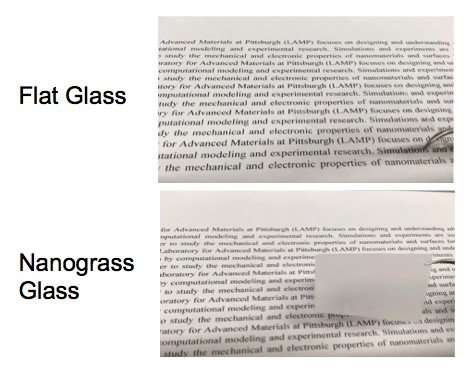Glass with switchable opacity could improve solar cells and LEDs

Using nanoscale grass-like structures, researchers at the University of Pittsburgh, Pennsylvania have created glass that lets through a large amount of light while appearing hazy. This is the first time that glass has been made with such high levels of haze and light transmittance at the same time, a combination of properties that could help boost the performance of solar cells and LEDs.
The glass exhibits another remarkable quality: It can be switched from hazy to clear by applying water. This could make it useful for creating smart windows that change haze or opacity to control the privacy of a room or to block glare from sunlight.
"Switchable glass available today is quite expensive because it uses transparent conducting layers to apply a voltage across the entire glass," said Paul W. Leu of the University of Pittsburgh's Swanson School of Engineering, leader of the research team. "Our glass would be potentially less expensive to make because its opacity can be switched in a matter of seconds by simply applying or removing liquid."
In Optica, The Optical Society's journal for high impact research, the researchers describe their new nanograss-based glass, which achieves a record 95 percent light transmittance and a similarly high degree of haze at the same time. The researchers experimented with glass etched with nanograss structures from 0.8 to 8.5 microns in height with "blades" each measuring a few hundred nanometers in diameter.
The discovery of switchability was one of serendipity. "I was cleaning the new nanograss glass when I discovered that cleaning it with water made the glass become clear," said project lead, graduate student Sajad Haghanifar. While the discovery was incidental, it can be easily explained. "The water goes between the extremely hydrophilic nanostructures, making the nanograss glass act like a flat substrate. Because water has a very similar index of refraction to the glass, the light goes straight through it. When the water is removed, the light hits the scattering nanostructures, making the glass appear hazy."
Using nanograss to improve solar cells
Leu's group developed the new glass to improve the ability of solar cells to capture light and turn it into power. Nanostructure patterns can prevent light from reflecting off the solar cell's surface. These structures also scatter the light that enters the glass, helping more of the light reach the semiconductor material within the solar cell, where it is converted into power.

The new glass uses a unique pattern of nanostructures that looks much like grass. Because the structures are taller than previously-used nanostructures, they increase the likelihood that light will be scattered. Although glass with the nanostructures appears opaque, tests showed that most of the scattered light makes its way through the glass.
The fact that the glass is highly hazy and exhibits high transmittance could also make it useful for LEDs, which work in a way that is essentially the opposite of a solar cell, by using electricity that enters a semiconductor to produce light that is then emitted from the device. The new glass could potentially increase the amount of light that makes it from the semiconductor into the surroundings.
Finding the right 'grass' height
The researchers found that shorter nanograss improved the antireflection properties of the glass while longer nanograss tended to increase the haze. Glass with 4.5-micron-high nanograss showed a nice balance of 95.6 percent transmittance and 96.2 percent haze for light with a 550-nanometer wavelength (yellow light, a component of sunlight).
Although more work is needed to estimate the exact cost of manufacturing the new glass, the researchers predict that their glass will be inexpensive because it is easy to make. The nanostructures are etched into the glass using a process known as reactive ion etching, a scalable and straightforward method commonly used to make printed circuit boards.
To turn the glass into a smart window that switches from hazy to clear, it would require placing a piece of traditional glass over the nanograss glass. Pumps could be used to flow liquid into the space between the two glasses, and a fan or pump could be used to remove the water. The researchers also showed that in addition to water, applying acetone and toluene can also switch the glass from hazy to clear.
"We are now conducting durability tests on the new nanograss glass and are evaluating its self-cleaning properties," said Haghanifar. "Self-cleaning glass is very useful because it prevents the need for robotic or manual removal of dust and debris that would reduce the efficiency of solar panels, whether the panels are on your house or on a Mars rover."
More information: Sajad Haghanifar et al, Ultrahigh-transparency, ultrahigh-haze nanograss glass with fluid-induced switchable haze, Optica (2017). DOI: 10.1364/OPTICA.4.001522
Journal information: Optica
Provided by Optical Society of America




















